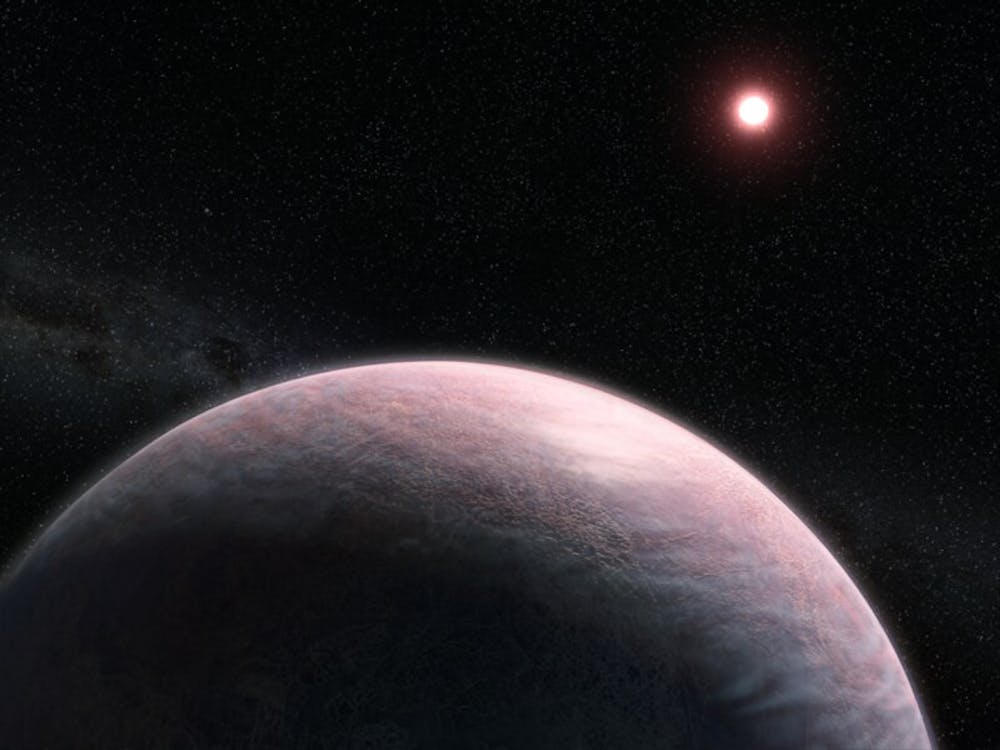Just more than a year after its launch, the James Webb Space Telescope (JWST) has confirmed the existence of its first exoplanet, discovered by a team of astronomers at the Johns Hopkins University Applied Physics Laboratory (APL). The Earth-sized planet, LHS 475 b, orbits a red dwarf star approximately 41 light years from Earth in the constellation Octans.
LHS 475 b was already suspected to exist based on measurements taken by NASA’s Transiting Exoplanet Survey Satellite (TESS). TESS uses single-band photometry to take large-scale images of the sky and can detect minute changes in light from stars to identify the presence of an exoplanet passing in front of its star — a process known as transiting.
In an email to The News-Letter, APL Mission Area Executive for Civil Space Jason Kalirai explained the difference between previous missions, including TESS and JWST.
“For transit observations, large field missions like Kepler and TESS are fantastic for statistical studies — how many stars have planets, and what is the distribution of planet types — and also can give us hints on whether certain exciting discoveries are in our nearby galaxy,“ he wrote. “But these missions are also smaller and may lack the sensitivity to yield a conclusive result on any given object. In such cases, we can turn [to] Webb’s powerful mirror and sensitive instruments to get a clear picture.”
As Kalirai mentioned, the TESS data lacked the detail necessary to validate a planet’s existence, leading scientists to further investigate with the JWST.
APL Staff Astronomer Kevin Stevenson outlined the reasoning for this choice in an interview with The News-Letter.
“There were signs of a dip that was periodic, but there is a process where you have to validate that the signal is in fact from a planet and not from something else,“ he said. “It could be some sort of background binary star system, for example, that is unresolved in the TESS pixels. There are lots of different false positives in the tests, datasets and people are working through to validate each of these targets.”
Unlike TESS, JWST observes individual targets rather than taking wide field-of-view images. Webb’s Near-Infrared Spectrograph verified the planet's existence within two transit observations, seen when a planet passes between a star and the observer.
According to Stevenson, it is particularly striking that Webb observed a planet that is 99% the size of Earth.
“Missions like Hubble, Spitzer and Webb just weren't designed for detection. They were designed for other things, but they work well for the characterization of exoplanet atmospheres,“ he said. “It was in some ways surprising that JWST’s first exoplanet discovery was of a rocky Earth-sized exoplanet because that's not what it's designed to do. It was good timing more than anything else we had.”
For the APL team, the question is whether rocky planets around smaller stars, such as the M-type red dwarfs — a class of stars that are smaller and cooler than the Sun — orbited by LHS 475 b, can develop atmospheres.
While JWST was not designed for detection, one of its strong suits is the ability to take spectrographic analyses of the planets it observes, a process elaborated on by Kalirai.
“One of the most promising [of Webb’s capabilities] is to spectroscopically analyze the light from a nearby star as it passes through an orbiting exoplanet’s atmosphere to us. By taking such spectra both when the exoplanet is in front of the star and when it is behind the star, we can measure the chemical composition of the exoplanet,” he wrote. “This is a very exciting frontier in exoplanets and enables a new step in our understanding of what our place in the Universe is.”
With this goal in mind, Webb took a transmission spectrum of LHS 475 b to determine if it had an atmosphere and, if so, its composition.
According to Stevenson, the data can be interpreted one of two ways: either the planet has no atmosphere or an atmosphere composed nearly entirely of carbon dioxide.
“When you have heavy molecules, high-mean molecular weight molecules, it shrinks the signal sizes to the point where we can't really see them. On top of that, if you add a cloud or haze layer, it really masks the signals that we're looking for. So we're kind of left with two possible options: either it doesn't have an atmosphere, like Mercury or Mars, or it has a really thick atmosphere that's cloudy, like Venus,” he said.
While determining if LHS 475 b has an atmosphere will require greater investigation, Stevenson notes that the overall goal of this mission is not to examine individual planets. The researchers hope to narrow the direction of future research by determining which types of planets are most likely to have the conditions necessary to support extraterrestrial life.
“If we want to use JWST to search for biosignatures on a planet, that's going to require large [amounts of] telescope time,“ he said. “Understanding whether or not these planets even have atmospheres is sort of the first step toward that search. If we can identify that this group of planets over here that are most likely to have atmospheres and this group of planets over here are not, [we are able] to focus our time and energy.”
In the coming months, the APL team will use JWST to investigate four additional similar exoplanets to further determine if M-dwarf stars can support atmosphere-bearing planets.
Stevenson highlighted that the team is closer to answering the age-old question of the existence of extraterrestrial life.
“People have been asking themselves ‘Are we alone?’ for millennia. Now is the first time where we have the technology to actually be able to answer that question whether it's with JWST or the next generation of space telescope,” he said. “We're at that point where in our lifetime, we will hopefully be able to answer that question.”





